 This weekend saw the 7th Think Visibility conference with a mixture of presentations and networking. From Analytics, to video, branding to SEO the conference took in a lot of different streams and provided a fantastic insight into what you should be doing for each of these disciplines.
This weekend saw the 7th Think Visibility conference with a mixture of presentations and networking. From Analytics, to video, branding to SEO the conference took in a lot of different streams and provided a fantastic insight into what you should be doing for each of these disciplines.
For those who didn’t attend, or who want a recap, we’ve compiled our favourite tips of the day.
There were also the usual party events with a Weakest Link style quiz alongside two nights of networking and drinks. Dom Hodgson pulled off another fantastic event and it’s great to hear the next two Thinkvis events have already been scheduled (with another additional event potentially coming soon).
As the conference was in two streams, myself and Anna did our best to see as many as we could, alongside both speaking at the event. Below are the tips we found useful for the talks we attended. We also welcome any more comments from attendees below.
SEO for Ecommerce
By Barry Adams
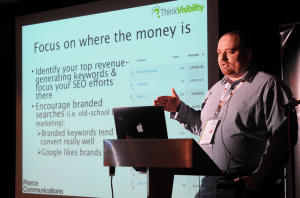 – Identify successful landing pages and consider increasing your price to discover maximum profit per item.
– Identify successful landing pages and consider increasing your price to discover maximum profit per item.
– eCommerce site structures need to be great – use breadcrumbs, internal searches, faceted navigation (such as Amazon use in their top nav) and filters.
– Don’t hide images in JavaScript. Make them high res, easy to share, include alt tags and build a filter in Google Analytics for viewers by image search so you can see how they convert.
– Rewrite or spin descriptions. Include long tail versions of keywords in descriptions as manufacturers don’t always use terms that users use.
– Put delivery information on the product page to reduce drop outs and incentivise with special offers (e.g. spend x more to get free shipping)
– Never 404 out of stock products, show relevant alternative products instead. Even if a product is discontinued you should 301 but never 404.
– If products are being discontinued and people know, you can increase the price and let people know you can still get it from them
– Make sure you are on Google shopping and build a filter to track this (see bada.ms/trackgoogleshopping for tips on making this filter)
– Sign up for review sites, aggregate product reviews (such as by adding to them to Revoo or using Schema).
– Prevent duplicate pages using: Robots.txt, Canonical tags, No index/follow, hide facet links in JavaScript, use XML Sitemaps and manage parameters in Google Webmaster Tools.
– For link building use blogger outreach, awards, giveaways, guest posts, press releases, article marketing and blogger events.
– Put social share buttons on every product page and order confirmation page
The Rise of Brands in Search
By Malcolm Slade
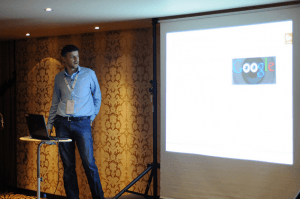
– The bulk link building and “one size fits all” days of SEO are over, now we are part of PR and outreach and generating a brand.
– Websites are either brands (big household names), forced sites (heavily “SEOed” sites that don’t deserve to rank) and those in between. Googles loves brands best.
– It is very safe for Google to use brands in their results, as customers have already proved they are a good result by shopping there.
– It’s easier for brands to get PR and be promoted by journalists, as many will go direct to big brands for quotes.
– Google could get a good indication of how big brands are by looking at the amount of branded traffic. They can also see keyword brand traffic (e.g. Admiral insurance) and this gives a good association.
– The black hole effect – When a site draws a lot of clicks in the results, no matter where it ranks in the list. Helps show it as a brand and is a great way to get more views regardless of top five placement.
– Exact match domains rank really well as the anchor text links they have make it appear like a brand and one that is highly relevant.
– Becoming a recognised brand can’t happen overnight. Everything is about getting noticed. Therefore you must improve your search snippets, create great content, build links & mentions and drive brand traffic (such as by doing other forms of marketing online and offline).
– Although SEO’s are bored of Infographics people who don’t work in online marketing are not – they hardly ever see them so they can get attention.
– Innovate, don’t replicate – your website has to stand out from the crowd. It’s not enough to take bits you like from other websites.
– Your goal is to make a powerful brand that can rank for anything not an exact match domain that can rank for one thing.
Link Building Lessons From Swiss Toni
By Jon Quinton
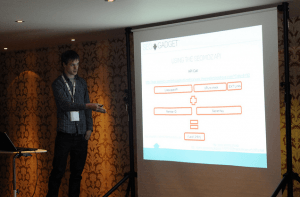
– If you can’t get links from a high profile site then view related sites to find more achievable ones.
– Use Buzz Stream to build lists of sites to target as you browse the Internet so you can approach them later.
– Use the Seomoz API and Linkscape to pull URL data so you can decide which site is best when performing outreach.
– When you want a link, you need to think “what does the blogger want from this, and what is in it for the readers? The blogger has to get traffic and their readers have to be happy. Everyone has to win.
– Use google docs importxml feature to scrape information from pages (see slides for formula).
– Scrape lists of blogs and then use SEO tools for excel to find out on page information about them.
– Try to email from a company email address.
– Use Google Docs importxml feature to scrape information from pages (see slides for formula). Scrape lists of blogs and then use SEO tools for Excel to find out on page information about them. Build a list of link prospects that you can go back to over time try to email from a company email address.
Actionable Analytics
Koozai’s Anna Lewis spoke about reporting analytics data and filtering to ensure you can make actionable insights.
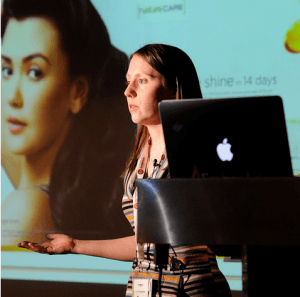 View the full presentation here
View the full presentation here
There was also an excellent Weakest Link style quiz game at lunch:
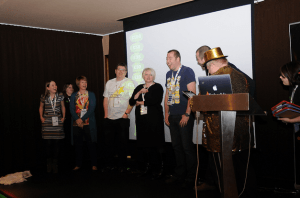 Video SEO
Video SEO
By Carla Marshall
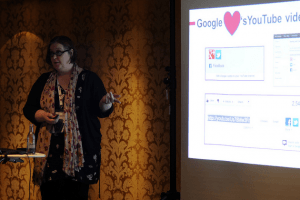 – YouTube gets 4 billion visits per day (Reuters) and video results appear in 70% of the top 100 listings (Marketing Week).
– YouTube gets 4 billion visits per day (Reuters) and video results appear in 70% of the top 100 listings (Marketing Week).
– Video SEO is not throwing a video on YouTube and hoping it goes viral.
– If you host video on your site you can use it for blogger outreach and use embed codes, social media, YouTube and direct content to spread awareness.
– Each video you produce needs its own separate URL and landing page.
– To get more exposure you can repurpose the content in your video with transcripts, presentations, PDF downloads, podcasts or screenshots as images.
– You need a video site map and should add schema as google are now using it for video.
– Posting a video to YouTube or other sites, is an easy way to get in to universal search results and build brand awareness.
– Register your video with YouTube paid promotions to enable ads. You can then advertise on your videos with external calls to action.
Your Time to Shine
Following on from last year’s hugely successful Your Time to Shine session, three more speakers took up the gauntlet of delivering presentations in bite sized chunks.
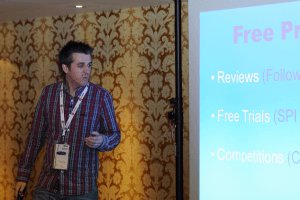 – Koozai’s Mike Essex spoke about the power of using freebies to build your brand, get links and sell more. This included giving away free products, free information, free help and free money. Mike’s slides will be posted to the Koozai blog this week.
– Koozai’s Mike Essex spoke about the power of using freebies to build your brand, get links and sell more. This included giving away free products, free information, free help and free money. Mike’s slides will be posted to the Koozai blog this week.
– The next presentation featured a very special guest from a galaxy far far away. Chewbacca spoke about why Google would be better if it ignored anchor text and why he hates George Lucas.
 – In the final talk Koozai’s Anna Lewis gave her second talk of the day, and ran people through the new version of Google Analytics, taking questions from the audience on other analytics issues.
– In the final talk Koozai’s Anna Lewis gave her second talk of the day, and ran people through the new version of Google Analytics, taking questions from the audience on other analytics issues.
25 Useful Things You Can Do With WordPress
By Dan Harrison
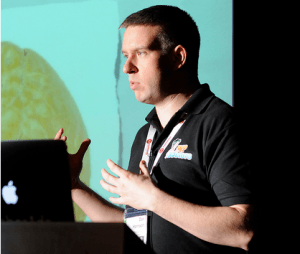 Dan’s talk included:
Dan’s talk included:
• Search Monitoring – how to track what people are searching for on your site
• Social Share Buttons – the easiest and fastest social media sharing buttons
• Sexy Buttons – how to create great-looking call-to-action buttons with WordPress
• Static Websites – how to make WordPress static
For a recap of all 25 tips you can download Dan’s presentation handout.
Saying Stuff is Dead is Dead
By James Carson
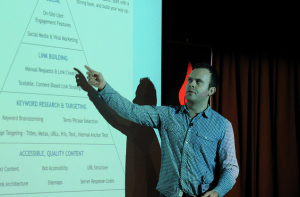
– Facebook isn’t dead – Google+ has had a very low takeup amongst “non SEO’s” and has far more interaction. They are also refining what they do such as with the new timeline.
– SEO isn’t dead – And things like Panda prove that good and strong content can rank well, if we do things right.
– “Endism” – the constant need to say things will end is not just true in our industry. TV was said to mean radio and movies would die but they did not.
– Saying things will die sells magazines and is great link bait. People often say it just to be controversial.
– Likewise don’t assume something will “kill other products” just because of a rapid rate of growth. E.g. Pinterest growing 4000% does not mean it will kill any other site.
– To stop the idea that SEO is dying – make sure you have a good Analytics, outreach, content and design strategy.
– Prioritise: Just because we can do 101 different marketing things doesn’t mean we should lose focus from what works.
– Don’t trust statistics without context, or marketing gurus who say drastic headlines just to sell more books.
– The traditional SEO pyramid is wrong. James proposed a new model, which you can read about here.
You can view the slides for this talk
From URL To Result
By Pierre Far – Webmaster Trends Analyst at Google
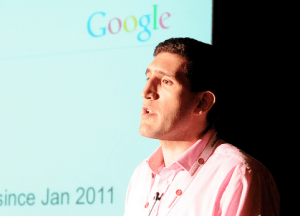
– Google gets URLs by crawling, links, site maps and the add URL feature.
– There are always more URLs than Google can fetch, so they try to get as many as possible without destroying your website. To do this they use a relaxed crawl rate.
– Google increase the URL crawl rate slowly and see if response time goes up. If your site can’t handle the crawler they will not crawl much of your site.
– Googlebot can be blocked from accessing your server, so you need to make sure your hosts have no issues or they will think your site is down.
– Google crawl more pages than those in your sitemap but it does help them decide which pages are more popular.
– Setup email forwarding on webmaster tools as a priority – this is very important so you don’t miss any error messages.
– Make sure your 404 page delivers a 404 status – or it will get indexed which happens a lot.
– Google has to pick the best URL and title for your content. They can change it to better match the query. They then generate a snippet and site links. Changing them improves the CTR. It’s as if you are writing a different title for each query
Picture credits: Steven Lilley (with loads more great photos).
We’d love to hear what you thought of the tips, or if you have any more from the day.
Leave a Reply